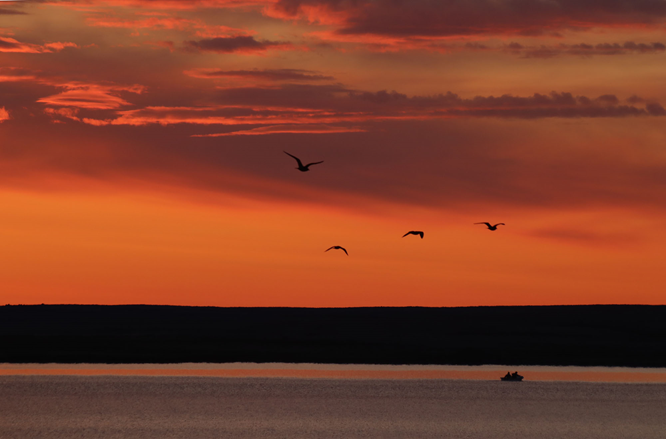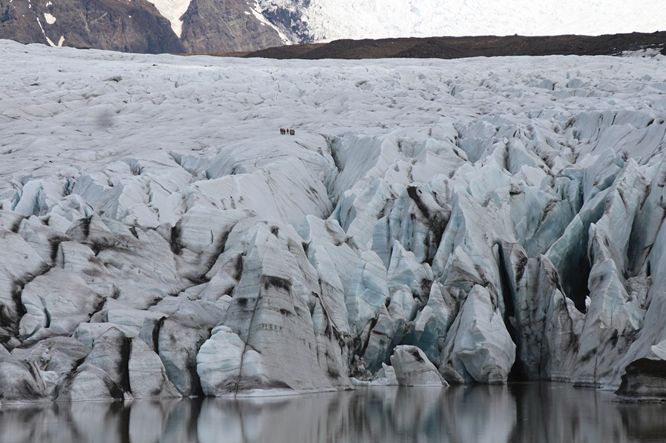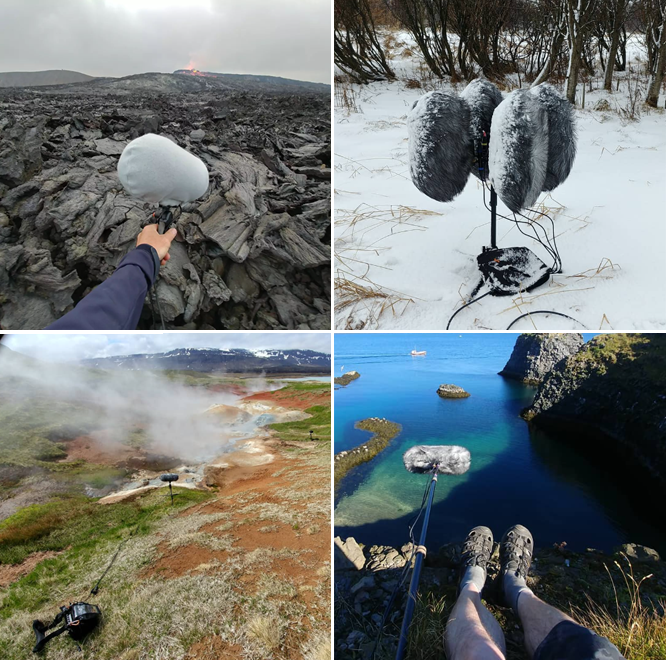

:: Holmavatn lake, Iceland (photo : Magnús Bergsson)
The recent spate of pandemics is testament to the spread of human activity into areas that used to belong to animals. These have become zones where diseases can jump from animal to human and find new life, and new deaths. Capital’s restless need for extraction means that natural habitats and wildlife are increasingly rare. In the arts, there is a microgenre dedicated to these vanishing worlds called “field recording.” It means that a person, sometimes accompanied by helpers but most often venturing alone, sets out to sites untouched by humans, and makes sound recordings there. They are shared on sites like Freesound.org or SoundCloud, sold as “sound effects” or “nature CDs,” and occasionally exhibited in galleries as sound art. Many tracks are long, unedited recordings that can last half an hour or more, as the subtle theme and variations of a single location allow the careful listener to sink into the details.
Headphones are essential for picking out the small details that provide much of the thrill, meaning that this is work most usually received alone, like the technology of a book. It requires sustained bouts of close attention, hard to come by in a culture that is driven by interruption, distraction and spectacle. Most recordings are never released, they are stored on hard drives or else deleted or lost. And even those that are publicly available remain, in the most literal sense, documents of the background.This is art where there is no central figure, no earworms, melody, or narrative pull, no obvious place where we can project our bodies into. So even though tracks can be found on Spotify or streamed on soundscapes-app.com, they can be heard without listening to them. Perhaps they are like most video installations, pointers to the place where art might be received, if only we had the time. It seems that the digital law of maximum visibility has inadvertently created new forms of invisibility. These recordings are hidden in plain sight.
Magnús Bergsson is a dedicated field recordist whose public home is the blog fieldrecording.net. Since October 2009, he has written a page each month; and on every page, there is at least one recording. There are beautifully made photographs, along with detailed technical notes, describing his equipment and how it was used and where it was placed. He describes deep landscape encounters, mapping out an always-changing geography that is made up of earth and sound.
Walter Benjamin wrote that there are two kinds of storytellers: the first stays in the same place their whole life, sharing the deep lore of home; the second wanders restlessly, bringing stories from one place to another. [1] Bergsson is the first kind of storyteller. While he works tirelessly, and has invested both money and time into acquiring the very best gear he can buy, often customizing it because of shortcomings he notices and tries to overcome in the field, he records only in his native home of Iceland. This framing is central to his work, along with the invitation to listen to a country that has largely vanished. What he is busy recording are ghosts.
His practice takes him to nature reserves in Flói and Jökulfirðir, sandy wastelands created by glacier melt in Skeiðarársandur, small fishing villages near the Arctic Circle, a sheep shield near his childhood home in Hvítingshæðir. Lake Hólmavatn offers him the chance to record the sound sparks caused by sea foam trapped then released by pebbles along the shore. Ice caves in the Svínafellsjökull glacier drip gloriously. World Oceans Day (June 8) finds him in the Hraunhafnartanga Peninsula, listening to an overwhelming surf, while the Látrabjarg Cliffs are home to millions of birds in the westernmost part of Europe.
Some of his most astonishing tracks are the result of his steady return to glaciers across the country. As Bergsson notes in his blog, “Glaciers usually have the strong smell of fresh oxygen that glaciers have captured in ice and compressed into locked bubbles for hundreds and thousands of years. This smell from the past is like from another world.”
The natural world is not his only recording studio. He regularly joins protests against a government ruled by corporations (“business gangsters,” he calls them [2]), and records speeches along with the rhythms of street solidarity as marchers bang on whatever they can, raising their voices against political corruption. His remarks on a succession of global climate meetings are alternately cutting and despondent. “Whatever the mainstream media says, the Paris talk COP21 was a fraud. The outcome was almost nothing, just promises. For me and many others it is too late.” [3] His blog reflections make clear that his deep listening practice is part of a wider circle of political gestures that resist consumerism and extractivism. Little wonder then that these hard-won recordings are not for sale.
It is easy to go into a special mood when I think of the Icelandic highland and all the fabulous moments I have experienced there twenty to thirty years ago. This quiet black desert gives me always a wonderful feeling. Just like I am in love. [4]
Again and again, his blog writing evokes the Iceland of his childhood. Because his memories are largely made out of sounds, what he conjures is a country without so much mining and airplanes, tourism and traffic. He is forever in search of quiet places, such a strange irony in this moment of maximum impacts and exposure. One could imagine a field recordist aiming instead at the largest, most unusual, most varied sounds possible, never before heard. But instead, he launches himself into faraway landscapes with his carefully curated gear in order to record almost nothing at all. On February 2016, he travelled to one of his “secret places,” sites where no one visits because there is “nothing” there. In his recording (fieldrecording.net/2016/02/), I hear a distant stream; occasionally a dunlin or golden plover calls out. A treasure of quietude. On World Listening Day in the same year, he visited the Kjalhraun lava field to record the wind blowing softly over the grounds. With typical precision, he notes that “thermal heat from the sun makes the air unstable so sound waves did not travel long distances.” And then later, “silence is my favourite recording material.”
Nothing is closer to a perfect experience as being alone in the wilderness, as far from any machines or human activity as you can. And when it is in cold or high altitude with no, or very quiet animal spaces, your sense organs automatically start to detect many things you may have never noticed before. [5]
Bergsson is an amateur. The word has Latin roots, it means “lover” or “friend.” He is fully committed to his practice. His breathing, waking, thinking life revolves so centrally around his work. His devotions are complete, the work is sublime. And yet he seeks so little attention for it, so little reward, or any of the external markings that signal “success.” He is content to put forward maximum effort not so that he can get somewhere else or become someone else. He is not motivated by lack. You could argue that he is demonstrating his privilege, that he doesn’t have to turn his efforts into money, his blog isn’t full of Patreon come-ons, his sound tracks have no advertising in them, no reminders to SUBSCRIBE, to LIKE, because he’s not building a brand, bulking up his resume, going viral. What a fucking relief. At the heart of his practice is someone willing to say no to corporate culture.
I can’t begin to describe the hours of pleasure Bergsson has brought me, simply by listening to him listen. I want to let everyone in on the secret but I know, I get it. You don’t have the time. You have priorities. Simone Weil, the Marxist mystic, wrote that attention is prayer. I can feel the capacity for attention build as I absorb these tracks, and along with it, a propensity for new hopes. Here are small offerings to a natural world that is resplendent in its vocalizings, opening a door onto secret worlds of silent pleasure.
[1] Benjamin, Walter. “The Storyteller: Reflections on Nikolai Leskóv.” In Illuminations, edited by Hannah Arendt and translated by Harry Zohn. New York: Harcourt, Brace & World, 1968
[6] fieldrecording.net/2018/12/
*
Mike Hoolboom began making movies in 1980. Making as practice, a daily application. Ongoing remixology. Since 2000 there has been a steady drip of found footage bio docs. The animating question of community: how can I help you? Interviews with media artists for 3 decades. Monographs and books, written, edited, co-edited. Local ecologies. Volunteerism. Opening the door.

:: Skaftafellsjökull's glacier, Iceland (photo : Magnús Bergsson)
In August 2018, he set up microphones both above and below the water in a lagoon and turned his recorder on, certain that, as usual, his gear placements were not ideal. But around midnight, the glacier began to walk through the lagoon. What is the language of ice? The grammar of shards and crackling fragments? This track features delicate underwater flows and a fierce shimmer of ice particles until, around the 26-minute mark, a slurry of snow shifts, and the mountain begins to move with a thunderous step, featuring great sliding skids of ice, the slow motion bending of vast ice sheets, a haptic delirium of texture and flow. This track, and the one he posted the following month (fieldrecording.net/2018/09) are lent poignancy by the fact that glaciers are disappearing. In the next few decades, they will be only a memory.

(photos : Magnús Bergsson)
There are too many recordings to even begin the detailed examination they deserve. A book or two would help. But one of the identity traits Bergsson shares with his field recording companions is that he is a birder. He often seeks out landscapes rich in bird life, and not only can he identify every animal, but he can hear the way they interact, how their voices change in different environments, how they get along. The “dawn chorus”—the moment when birds gather at day break to celebrate a new day—is a commonplace in field recording, and Bergsson is more than happy to wake up in the wee hours of the night in order to set his gear up in exactly the right spot. But more extravagant than his bird operas is a singular recording made on Elliðaey Island, a small and remote setting filled with cliffs and birds. Like many of his tribe, he likes to make long recordings, so that he can exit the frame and allow real world encounters to occur without a human presence to alter the course of events. After his recording sessions, he spends many hours at home listening through the long takes, marking and selecting the best intervals. From the island’s many moments, he has chosen a remarkable half-hour featuring puffins, small seabirds that dive into the water for food. Their population is in marked decline because of changes to the ocean’s biosphere, Bergsson notes that half their burrows were empty. But on this sound recording, [6] they hover overhead, flitting just past the microphone, creating an astonishing intimacy. It is as if the listener has been granted wings and can roam amongst them, that’s how close they sound. The touch of their feathers, the quick flap of their wings race from side to side as they circle the shore. If the wind, the trees, the beach or the seashore had ears, this track could serve as their report.
 |
envoyer par courriel | 
| imprimer | Tweet |
